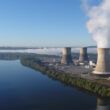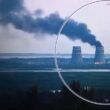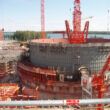Nuclear energy’s positive role in carbon mitigation
By Stephen M. Goldberg, January 8, 2009
As I’ve written in earlier rounds of this discussion a multifold increase in nuclear power deployment across the globe would substantially mitigate against future climate disruptions.
Such conclusions are far from mine alone, MIT and the International Energy Agency have concluded the same thing and the State Department’s International Security Advisory Board predicts that global energy demand will double by 2030 and that the expansion of nuclear energy, especially in less-developed countries, is “inevitable” due to increased future costs for oil and natural gas and the fact that nuclear power produces no carbon emissions.
Much of the debate at the U.N. Climate Change Conference in December centered on the availability of “adaptation funds” for less-developed countries so they will be able to cope with devastations wrought by climate change. Under the Kyoto Protocol’s financing system, the world’s developed economies would buy emission-reduction credits from less-developed countries or build clean energy projects in those countries. Such a system, if fully adopted, would likely trigger significant financial incentives to deploy new nuclear energy globally.
Without Kyoto, nuclear energy’s global footprint will likely increase if national climate policies are adopted that include carbon taxes, cap-and-trade systems, or other alternatives that provide significant incentives to climate-friendly energy technologies and disincentives to carbon dioxide emitting ones.
The nuclear energy plans that the United Arab Emirates (UAE) has adopted are an excellent case in point. The UAE’s interest in evaluating nuclear energy is motivated by its need to develop additional sources of electricity to meet its future demand projections, ensure the continued rapid development of its economy, and a desire to do so in a socially responsible manner. Recent analysis has concluded that the UAE’s annual peak demand for electricity is likely to rise to more than 40,000 megawatts by 2020, reflecting a cumulative annual growth rate of about 9 percent from 2007.
If we reflect back on the essence of the Global Nuclear Energy Partnership (GNEP), the plan was created to help manage the growth of global nuclear power without a parallel spread of enrichment and reprocessing technologies worldwide, providing infrastructure development support as well as nuclear fuel-cycle services. As the Obama administration develops its climate-mitigation strategy, it should try to capture these two core pieces of GNEP that merit continued support, strengthened international fuel supply and disposition schemes as well as a workable program for international fuel “take-back.”
Regarding the first part, I refer to Argonne’s TRUST concept or Terms for Reliable Uranium Service Transactions through leasing. TRUST would provide for fuel supply and used fuel management in a global marketplace. A guiding principle of the program is its reliance on existing market structures such as commercial arrangements that have been successful in the United States and other countries with substantial nuclear power programs. The terms of the lease would be limited to the assembly of fuel components and services, use of the fuel, and storage of spent fuel at facilities owned by the nuclear utility. The lease would end when, and if, the spent fuel is removed from the site, a so-called “cradle to casket” scheme so that long-term disposition decisions would be determined after the lease has expired, which could include return of the fuel to the supplier.
Regarding take-back regimes, a good start would be to strengthen our domestic back-end programs, offering interim storage approaches to meet the Energy Department’s contractual obligations to U.S. nuclear plant operators, progress there could be applied internationally and could entail expanded onsite dry cask storage, regional storage, centralized storage, and/or establishing one or more international interim storage facilities.
To meet this world of increased nuclear power, the United States must invest in research into advanced nuclear fuel-cycle technologies, including enhanced use of advanced computation simulation approaches that will lead to new, transformational, and more proliferation-resistant nuclear technologies. Funding such groundbreaking research is a better proposition than running after international competitors to find variants on traditional reprocessing techniques or evolutionary modifications of existing reactor designs.
Finally, when it comes to the dangers of proliferation in this new global nuclear world, my thoughts are best captured by James Hanson, the head of NASA’s Goddard Institute for Space Studies. He wrote, in an open letter to the President-elect, that “potential proliferation of nuclear material will always demand vigilance, but that will be true in any case, and our safety is best secured if the United States is involved in the technologies and helps define [the] standards.”
Topics: Nuclear Energy
Share: [addthis tool="addthis_inline_share_toolbox"]














